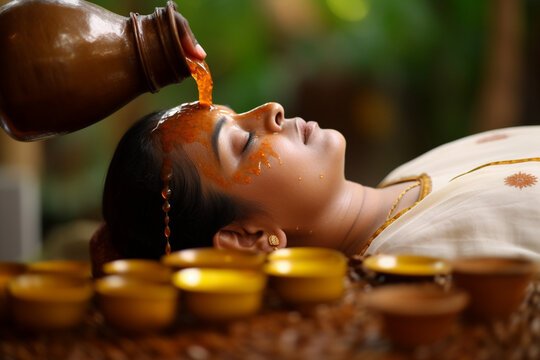Panchakarma, an ancient Ayurvedic detoxification and rejuvenation therapy, has been practiced for centuries to promote holistic health and well-being. Rooted in the traditional Indian system of medicine, Ayurveda, Panchakarma aims to cleanse the body of accumulated toxins (ama) and restore balance to the three doshas: Vata, Pitta, and Kapha. This comprehensive guide delves into the principles, procedures, and benefits of Panchakarma, offering insights into its role in modern wellness practices.
Understanding Panchakarma: The Fivefold Therapy
The term “Panchakarma” translates to “five actions” or “five treatments,” referring to the five primary procedures designed to purify the body:
- Vamana (Therapeutic Emesis): This process involves induced vomiting to eliminate toxins from the upper gastrointestinal tract, primarily targeting Kapha-related imbalances. It’s beneficial for conditions like asthma, chronic indigestion, and certain skin disorders. Anantama Ayurveda
- Virechana (Purgation Therapy): Aimed at expelling toxins from the lower gastrointestinal tract, Virechana uses herbal laxatives to cleanse the liver and intestines, addressing Pitta-related disorders such as jaundice, colitis, and migraines. Anantama Ayurveda
- Basti (Medicated Enema): Considered the most effective treatment for Vata disorders, Basti administers herbal decoctions or oils into the colon, alleviating issues like arthritis, constipation, and neurological conditions. Anantama Ayurveda
- Nasya (Nasal Administration): This therapy involves the administration of medicated oils or powders through the nostrils, purifying the head and neck region. It’s effective for sinusitis, migraines, and certain neurological conditions. Anantama Ayurveda
- Raktamokshana (Bloodletting): A less commonly practiced procedure, Raktamokshana involves controlled removal of small quantities of blood to eliminate toxins, particularly beneficial for skin disorders and conditions caused by blood impurities. Anantama Ayurveda
The Panchakarma Process: A Step-by-Step Approach
Panchakarma is a meticulously structured process comprising three main phases:
1. Purva Karma (Preparatory Procedures)
Before the main detoxification, the body is prepared through:
- Snehana (Oleation): Internal and external application of medicated oils to loosen toxins.
- Swedana (Sudation): Therapeutic sweating induced through steam baths to further mobilize toxins.
These preparatory steps are crucial for softening and dislodging toxins, facilitating their elimination during the main procedures.
2. Pradhana Karma (Main Procedures)
This phase involves the five primary therapies (Vamana, Virechana, Basti, Nasya, and Raktamokshana) tailored to the individual’s constitution and specific health conditions.
3. Paschat Karma (Post-Therapeutic Measures)
Post-detoxification care focuses on restoring the body’s digestive fire (Agni) and includes:
- Dietary Regimen: Gradual reintroduction of regular diet, starting with light, easily digestible foods.
- Lifestyle Modifications: Guidance on daily routines, yoga, and meditation to maintain the benefits of Panchakarma.
This phase ensures the body adapts smoothly post-detoxification, preventing the reaccumulation of toxins.
Benefits of Panchakarma
Engaging in Panchakarma therapy offers a multitude of health benefits:
- Detoxification: Eliminates accumulated toxins, enhancing overall health.
- Improved Digestion: Restores digestive balance, alleviating issues like bloating and indigestion.
- Enhanced Immunity: Strengthens the body’s natural defense mechanisms.
- Mental Clarity: Reduces stress and promotes mental well-being.
- Rejuvenation: Revitalizes tissues, promoting longevity and vitality.
These benefits underscore Panchakarma’s role in preventive healthcare and holistic wellness.
Considerations and Precautions
While Panchakarma offers profound benefits, it’s essential to approach it with proper guidance:
- Qualified Practitioners: Ensure treatments are administered by certified Ayurvedic professionals.
- Individual Assessment: Therapies should be customized based on individual health assessments.
- Medical Conditions: Certain conditions may contraindicate specific therapies; a thorough evaluation is necessary.
Adhering to these considerations ensures a safe and effective Panchakarma experience.
Integrating Panchakarma into Modern Wellness
Incorporating Panchakarma into contemporary health routines can be achieved through:
- Seasonal Detoxification: Engaging in Panchakarma during seasonal transitions to maintain balance.
- Complementary Therapies: Combining Panchakarma with yoga, meditation, and balanced nutrition for holistic health.
- Preventive Care: Utilizing Panchakarma as a preventive measure to address potential health imbalances before they manifest.
This integration aligns with modern wellness trends emphasizing holistic and preventive healthcare.
Conclusion
Panchakarma stands as a testament to Ayurveda’s profound understanding of the human body and its self-healing capabilities. By systematically cleansing and rejuvenating the body, Panchakarma not only addresses existing health issues but also fortifies the body against future ailments. As interest in holistic and preventive healthcare continues to grow, Panchakarma offers a time-honored pathway to achieving optimal health and well-being.
For those seeking an immersive experience in the heart of Rajasthan, consider exploring the offerings at Rajwada Desert Camp.



